|
|
|
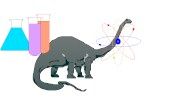
Evidence Appears Strong to Bolster Concept of Co-evolution, Scientists Say
CHAMPAIGN, Ill. – Are insects always just pests, or do they play a co-evolutionary role with the plants they eat? According to a chemical analysis of parsnip webworms and wild parsnips in the Midwest, pests and plants can and do adjust to each other to survive.
The idea of co-evolution is not new, but it is far from universally accepted. In 1964, Paul R. Ehrlich, now president of Stanford University’s Center for Conservation Biology, and Peter H. Raven, now director of the Missouri Botanical Garden and botany professor at Washington University in St. Louis, founded the study of co-evolution. They defined it as the process of reciprocal evolutionary change in interacting species.
They noted that plants produce chemicals that are toxic to insects, and that insects produce mechanisms to detoxify many plant defenses. However, while most scientists accept the notion that insects must adapt to their host plants, some have debated whether plants tailor their toxins specifically against insects.
With the help of museum specimens of parsnip plants, including some that predate the webworms’ post-1900 entry into the Midwest, University of Illinois entomologists May R. Berenbaum and Arthur R. Zangerl say they have strong evidence for both sides of the adaptation scenario. They published their findings in the Nov. 10 issue of the Procnal Academy of Sciences.
Today’s webworms and parsnips in Minnesota and in northern and central Illinois have adapted to each other, the scientists report. Webworms feed on the reproductive structures of parsnips, so resistance to the insect is vital to parsnip survival. At each site, levels in the plants of four defensive compounds, called ‘furanocoumarins’, match remarkably to the levels of detoxification enzymes in the insects.
‘If 30 percent of the plants have a particular chemical phenotype, then roughly 30 percent of the insects have the phenotype that permits them to live on those plants,’ Zangerl said. ‘You see quite a balancing act. This occurred to a remarkable degree in three of the four populations that we observed.’
To strengthen their case, the researchers examined pre-1900 museum specimens kept by the University of Illinois Herbarium. They found that the furanocoumarin compound sphondin produced in high levels in today’s parsnips was produced in low quantities or not at all in the museum specimens. It is sphondin, they found, that the webworms have a hard time metabolizing.
‘They have no genetic variation to be able to metabolize it,’ Berenbaum said. People have a hard time accepting the idea that plant traits represent a response to insect-caused damage. They assume that insects are minor annoyances to plants, like fleas on a dog, rather than major selective forces. We feel our data say that the evolutionary responses are reciprocal between these interacting species. This work also indicates how quickly plants can respond genetically to insect-caused damage.’ (Enquiries: Jim Barlow, Life Sciences Editor [e-mail: b-james3@uiuc.edu], News Bureau, University of Illinois at Urbana-Champaign, 807 S.Wright Street, Suite 520 East Champaign, IL 61820-6219, USA) "
Could Paleontology Help to Map the Structure of the Milky Way?

Recent work by Caltech astronomers (Leicht & Vasisht, New Astronomy, 3, pp. 51–57) has fortified earlier propositions of a strong correlation between evolutionary events such as the Cretaceous/Tertiary (K/T) extinction of the dinosaurs and galactic rotation. According to this, extinction events tend to happen when the sun moves through a spiral arm of our galaxy. The arms are actually ‘density waves’, which compress stars nearer to one another, causing a lot more stray comets and harmful radiation coming our way.
This could lead to a novel method of galactic mapping. Accurate measurement of the time and duration of mass extinctions could give us clues about the width and density of the galaxy’s spiral arms. Such a method would not only require greater resolution in dating these events than is currently provided by paleontology, but also im-proved definition of the bio-diversity before and after such changes.
It is remarkable to be able to propose that improved dating of the Earth’s sediments and its fossil record may improve our knowledge of the large-scale detail of our galaxy’s structure. Features of the other side of the galaxy may be locked in the rock beneath our feet! (Condensed: Steve Ringwood, ‘Views’, Astronomy & Geophysics, Journal of the Royal Astronomical Society) "
Toe Ons Nog Wurms Was - deur Antoinette Swart
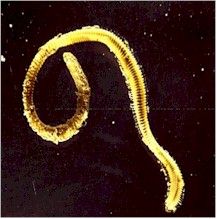 Gedurende net 35 miljoen
jaar, ’n oogwink in evolusie, het daar ’n ontploffing in die diversiteit van
dierelewe gekom, iets wat nog nooit daarvoor ůf daarna gebeur het nie. Hierdie tydperk
word ook die ‘Kambrium-radiasie’ genoem en het sowat 570 miljoen jaar gelede
plaasgevind. Gedurende die voorafgaande ongeveer 3 biljoen jaar was alge, die enigmatiese
Ediakare en miskien platwurms, die hoogste lewensvorme op aarde. PaleontoloŽ het in die
1940s die fossiele van groteske metasoŽ in die Ediakara-heuwels in Suidoos-AustraliŽ
gevind en hulle ‘Ediakare’ genoem.
Gedurende net 35 miljoen
jaar, ’n oogwink in evolusie, het daar ’n ontploffing in die diversiteit van
dierelewe gekom, iets wat nog nooit daarvoor ůf daarna gebeur het nie. Hierdie tydperk
word ook die ‘Kambrium-radiasie’ genoem en het sowat 570 miljoen jaar gelede
plaasgevind. Gedurende die voorafgaande ongeveer 3 biljoen jaar was alge, die enigmatiese
Ediakare en miskien platwurms, die hoogste lewensvorme op aarde. PaleontoloŽ het in die
1940s die fossiele van groteske metasoŽ in die Ediakara-heuwels in Suidoos-AustraliŽ
gevind en hulle ‘Ediakare’ genoem.
Hierdie diere was die oorheersende lewensvorm in die laat-Prekambrium en het tot aan die begin van die Kambrium oorleef (Kambrium fossielfondse wat in 1995 en 1996 in NamibiŽ gemaak is, staaf hierdie feit). Die kenmerk wat deur alle Ediakare gedeel word, is die totale afwesigheid van ’n kalksteen- of silikabasisskelet. Hierdie diere het sagte liggame gehad wat in sommige gevalle soos groot vere, gesegmenteerde wurms, meterlange donskomberse of geriffelde skywe gelyk het. Baie van die organismes het geen verband met bekende fauna nie en mag selfs tot ’n koninkryk van hul eie behoort.
Sommige paleontoloŽ soos James Gehling (University of South Australia, Adelaide) meen dat sekere Ediakare wel verwantskappe met gesegmenteerde wurms, jellievisse en primitiewe skulpdiere vertoon. Nog ’n teorie kom van Mark McMenamin van Mount Holyoke College, Massachussetts. Hy sien die laat-Prekambrium as ’n ‘Tuin van Ediakare’ waar groot diere met sagte liggame in harmonie met mekaar saamgeleef het en gevoed het deur fotosintetiese alge en mikro-organismes wat in hul liggame geleef het – baie soos sommige hedendaagse korale. ’n Verandering het egter plaas-gevind met die koms van die eerste predator, of dit ontwikkeling het uit die Ediakare of ’n ander organisme, is nog nie duidelik nie.
Die ontwikkeling van so ’n roofdier aan die begin van die Kambrium sou die evolusionÍre vonk verskaf het vir die ontwikkeling van organismes wat met mekaar sou wedywer wat betref spoed, wegkruipvermoŽ of wreedaardigheid. Dit sou dan oorsprong gee aan die radiasie van diere in die vroeŽ Kambrium. Die fossiel van so ’n roofdier, op die grens tussen Prekambrium en Kambrium is egter nog nie gevind nie. Ons moet ook onthou dat die vroeŽ Kambrium (Ī 535 miljoen jaar gelede) gekenmerk word deur kwistig-ontwikkelde organismes wat reeds koppe, segmente, bene, ’n skulp, voel-horings en kiewe gehad het, dit wil sÍ alle lewensvorme wat in hedendaagse diere teenwoordig is (asook ’n paar wat vandag reeds uitgestorwe is). Skielik het hierdie kwistige ontwikkeling egter opgehou, en vir die volgende 500 miljoen jaar was evolusie tevrede om net voort te bou op ou temas.
Vir baie jare moes paleontoloŽ probeer om die Kambrium-radiasie deur die fossielrekord te verklaar. Vandag gebruik meer en meer navorsers die genetiese rekord wat deur eeue heen na vandag se diere oorgedra is. Deur diere geneties met mekaar te vergelyk kan biochemici ’n idee vorm van watter gene in die verre verlede teenwoordig was en wat hul funksies kon wees. Die be-roemdste van hierdie gene be-hoort tot die sogenaamde ‘hox-groep’ (‘hoc-cluster’). Hox-gene is beplanners of program-meerders wat die selle van ’n embrio op die horisontale as plaas, m.a.w. hulle kodeer die selle wat hoort by die voorste, middelste of agterste deel van die embrio. Ander geen-groepe programmeer selle weer langs die vertikale as van die embrio en onderskei byvoorbeeld tussen die basis en bopunt van die been of vlerk.
Omtrent twee jaar gelede het paleontoloŽ, James Valentine van die Universiteit van Chicago en Douglas Erwin van die National Museum of Natural History in Washington DC, begin vermoed dat hierdie gene die antwoord op die vraagstuk van die Kambrium-radiasie kan wees. Die wyse waarop hierdie gene die liggaamsdele kan karteer, gee aan evolusie ’n meganisme om een deel van die liggaam te verander sonder om die res van die liggaam te verander. Sů kan segmente verdubbel word en nuwe aanhangsels gevorm word, waar daar voorheen geen aanhangsels was nie. Die probleem is egter die bewyse dat daar sulke gene in die verre verlede bestaan het en die feit dat gene van 500 miljoen jaar gelede nie fossileer nie.
Rudolf Raff, ’n evo-lusionÍre ontwikkelingsbioloog van Indiana University in Bloomington, het egter ’n antwoord hierop. Hedendaagse diere verteenwoordig slegs die toppe van die evolusionÍre boom en indien dieselfde geen in twee diere van verskillende takke teenwoordig is, můťt diť geen ook teenwoordig wees in hul gesamentlike voorouer. Deur diere wat morfologies nog verder van mekaar verwyder is, geneties met mekaar te vergelyk, kan bioloŽ afwaarts, langs die vroegste takke tot in die wortels (oorsprong) van die evolusionÍre boom, beweeg.
VrugtevlieŽ en paddas, twee veterane van die biologie laboratorium, is morfologies baie verskillend en behoort geneties ook baie uiteenlopend te wees. Gedurende die afgelope paar jaar het bioloŽ egter bewys dat die DNA-opeenvolging van die programmeringsgene van diť twee organismes besondere ooreenkomste toon. Sů is daar die geen ‘decapentaplegic’ wat die dorsale helfte van die vrugtevlieg-liggaam programmeer. Die geen is baie na aan die geen ‘Bmp-4’, wat die ontwikkeling van die ventrale deel van die padda programmeer. Sů min verskil die twee gene van mekaar dat indien ‘de-capentaplegic’ uit die vrugtevlieg-embrio onttrek word en in die padda-embrio oor-geplaas word, dit onmiddellik die ventrale deel van die padda se liggaam begin programmeer.
Al hierdie gegewens bevraagteken egter die ou opvatting dat die voorouer van alle diere slegs ’n ronderige platwurm was, wat eintlik net uit ’n klomp pulserende selle bestaan het. Op grond van die nuwe feite kon hierdie voorouer wel ’n gesegmenteerde wurm met oŽ, ’n hart, senuweesisteem en selfs bene en voelhorings gewees het. Nog ’n verduideliking kan wees dat alhoewel die programmeringsgene reeds in die voorouer teenwoordig was, dit nog nie op daardie stadium reeds vir oŽ, segmente, ens., gekodeer het nie. Nipam Patel, ’n ontwikkelings-bioloog van die Universiteit van Chicago, verduidelik dat die program-meringsgeen van die heden-daagse oog, in die Pre-kambrium net kodeer het vir ’n ligsensitiewe oogvlek.
Wat ook al die primitiewe Prekambrium organismes aangeskakel het om skielik te begin ontwikkel, dit sou vir daardie organismes baie makliker gewees het om nuwe liggaamsdele te vorm en selfs hul dorsale en ventrale kante om te ruil, as vir die organismes van vandag. Die wÍreld van die Prekambrium was ekologies leeg n enige lewensvorm wat deur evolusie ontwikkel het, sou ’n niks gevind het om te bly voortbestaan. Die liggame was ook eenvoudig en groot veranderinge in die morfologie, sou nie ’n groot invloed op die organisme gehad het nie. Vandag se diere het egter vasgelegde liggaamsplanne en veranderinge kan slegs binne diť plan geskied, m.a.w. die eksperimentele fase van die Prekambrium is vir goed verby en ontwikkeling kan vandag slegs langs baie konserwatiewe kanale plaasvind. Bob Holmes sÍ dan ook tereg: ‘Looking back now, we can shed a tear for those days so long ago when life was young and we were worms.’ (Bron: Bob Holmes. 1997. ‘When we were worms’, New Scientist) "
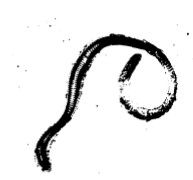
Discovery of New Fossils in Gobi Desert of Mongolia Provides Important Insight into Early Mammal Evolution
DECEMBER 3, 1998 – A team of scientists announced today in the journal Nature the discovery of new specimens of an early relative of marsupials called ‘Deltatheridium’ that provide unprecedented insight into the evolutionary split that eventually led to the rise of today’s marsupials and placental mammals. The fossils were uncovered at Ukhaa Tolgod, one of the world’s richest fossil sites, during the joint American Museum of Natural History/ Mongolian Academy of Sciences expedition to the Gobi Desert of Mongolia, in Central Asia. The physical features observed in the new fossils allow scientists to define for the first time which characteristics are unique to the marsupial lineage and allow them to draw a comprehensive family tree for both this group and our own progenitors, the placental mammals.
Marsupials, the group of mammals that includes opos and koalas, represent one of the three major branches of mammals living today. The other two branches are monotremes, which include the bizarre egg-laying duck-billed platypus, and placentals, which include most of the mammals familiar to us today, among them, humans. While scientists know that the fossil record for marsupials and their relatives stretches into the Mesozoic Era, known as the Age of the Dinosaurs, unraveling their evolutionary history has proved controversial because only very fragmentary fossils of this group have been found.
The two newly discovered Deltatheridium specimens, which are approximately 80 million years old, help fill critical gaps in the earliest stages of mammalian evolutionary history. The first of the new specimens is an adult with a nearly complete skull, jaws, and arm bones; the second is a juvenile with virtually complete jaws, various skull bones, and several additional bones from its body. Deltatheridium was an opossum-like mammal with very sharp molars and long canines, suggesting it may have been a carnivore. With a skull almost two inches [5,5cm] long, Deltatheridium was a relative giant in the Lilliputian world of Mesozoic mammals. Its diet probably included lizards and other early mammals. One of the specimens was preserved with a crushed fragment of a mammal skull (since broken remains are very rare at Uhkaa Tolgod, it is possible that the mammal was the Deltatheridium’s last meal. The location of Deltatheridium in Central Asia suggests that modern marsupials, which today are most diverse in South America and Australia, may have arisen from a lineage that actually originated in Asia.
Before the current discovery, scientists debated whether Deltatheridium should be placed in the placental lineage or the marsupial lineage. Study of the new fossils reveals unequivocally that Deltatheridium is an early relative of marsupials, and in fact is one of the earilest marsupial relatives ever discovered. Some of the features Deltatheridium shares with modern-day mammals is the large bony process at the back of the jaw for the attachment of chewing muscles and a distinct pattern of openings in the skull to accommodate blood circulation, but it lacked many other features that arose in modern marsupials.
The juvenile specimen found at Ukhaa Tolgod is particularly important because it died when its adult teeth were just beginning to emerge, so the sequence in which the teeth grew can be observed. Analysis of the teeth of the juvenile Deltatheridium provides one of the strongest links between this animal and modern marsupials for unlike any other group of mammals, marsupials replace only one tooth after birth, the last premolar. The juvenile specimen shows this same highly distinctive tooth replacement pattern.
Authors on the December 3 Nature paper are: Guillermo W. Rougier, assistant professor at the Department of Anatomical Sciences and Neurobiology at the University of Louisville, who is also a research associate in the Department of Vertebrate Paleontology at the American Museum of Natural History; John R. Wible, Section of Mammals at the Carnegie Museum of Natural History in Pittsburgh, who is also a research associate in the American Museum of Natural History’s Department of Mammalogy; and Michael J. Novacek, Curator in the Department of Vertebrate Paleontology at the American Museum of Natural History. (Enquiries: Elizabeth Chapman [e-mail: chapman@amnh.org] or Karen de Seve [e-mail: kdeseve@amnh.org], American Museum of Natural History) "
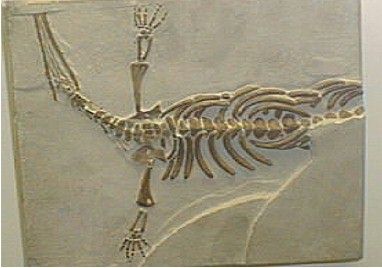
Mesosaurus, 45 cm long, with paddle-like feet and webbed toes, is the oldest reptile found in southern Africa (palaeontology exhibit at SA Museum, Cape Town)
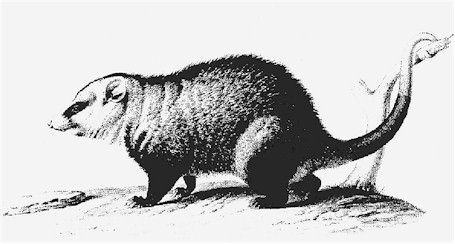
Virginian Opossum (Didelphis marsupialisvirginiana), a close relative of Deltatheridium.